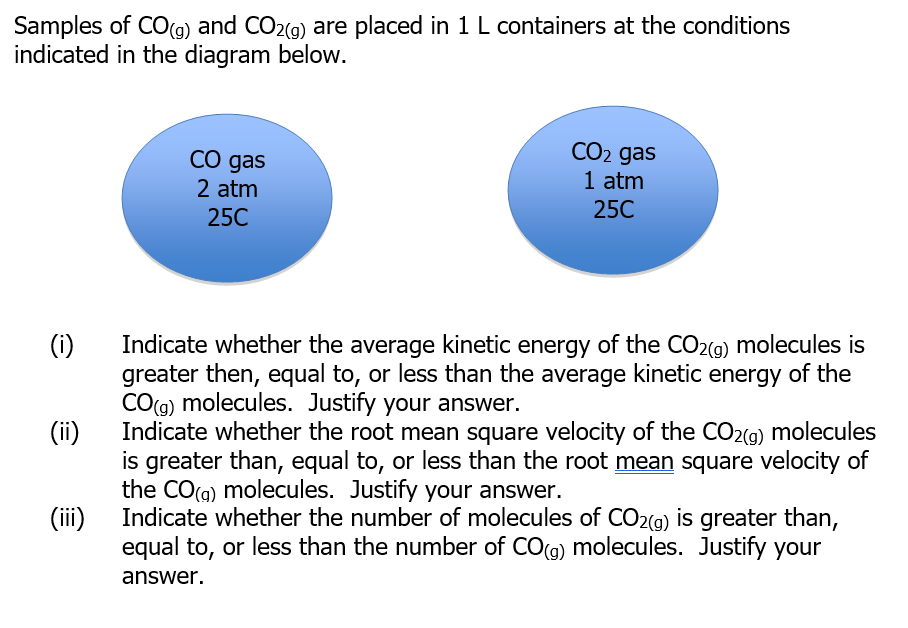Samples of CO9) and CO2(g) are placed in 1 L containers at the conditions indicated in the diagram below. CO2 gas 1 atm 25C CO gas 2 atm 250 (i) Indicate whether the average kinetic energy of the CO2(g) molecules is greater then, equal to, or less than the average kinetic energy of the CO(g) molecules. Justify your answer. (ii) Indicate whether the root mean square velocity of the CO2(g) molecules is greater than, equal to, or less than the root mean square velocity of the CO(g) molecules. Justify your answer. Indicate whether the number of molecules of CO2(g) is greater than, (i) equal to, or less than the number of CO(g) molecules. Justify your answer.
Samples of CO9) and CO2(g) are placed in 1 L containers at the conditions indicated in the diagram below. CO2 gas 1 atm 25C CO gas 2 atm 250 (i) Indicate whether the average kinetic energy of the CO2(g) molecules is greater then, equal to, or less than the average kinetic energy of the CO(g) molecules. Justify your answer. (ii) Indicate whether the root mean square velocity of the CO2(g) molecules is greater than, equal to, or less than the root mean square velocity of the CO(g) molecules. Justify your answer. Indicate whether the number of molecules of CO2(g) is greater than, (i) equal to, or less than the number of CO(g) molecules. Justify your answer.
Chemistry: An Atoms First Approach
2nd Edition
ISBN:9781305079243
Author:Steven S. Zumdahl, Susan A. Zumdahl
Publisher:Steven S. Zumdahl, Susan A. Zumdahl
Chapter8: Gases
Section: Chapter Questions
Problem 30Q
Related questions
Question
Gas problem; please all components of the problem as it is only 1 problem. Thank You!

Transcribed Image Text:Samples of CO(g) and CO2(g) are placed in 1 L containers at the conditions
indicated in the diagram below.
CO2 gas
1 atm
250
CO gas
2 atm
25C
(i)
Indicate whether the average kinetic energy of the CO2(g) molecules is
greater then, equal to, or less than the average kinetic energy of the
CO(g) molecules. Justify your answer.
(ii)
Indicate whether the root mean square velocity of the CO2(g) molecules
is greater
the CO(g) molecules. Justify your answer.
Indicate whether the number of molecules of CO2(g) is greater than,
equal to, or less than the number of CO(g) molecules. Justify your
equal to, or less than the root mean square velocity of
(iii)
answer.
Expert Solution
Step 1
- Average kinetic energy(K.E.):- It is defined as the 3/2 of the product of Universal gas constant (R) and the temperature(T) per mole. That is,
- K.E. is directly proportional to T that is if T increases then K.E. also increases and vise- versa.
- Root mean square velocity(vrms):- It is the square root of the mean of squares of the velocities of individual gases.
where,
T= temperature[in kelvin(K)]
R= Universal gas constant ()
M= molecular mass of gas
- Number of molecules(N) is the product of number of moles(n) and the Avogadro number(NA ).
- Number of moles(n) is the ratio of mass (m) of compound (in g) and the molar mass (M') of compound(in g/mol).
Trending now
This is a popular solution!
Step by step
Solved in 4 steps

Knowledge Booster
Learn more about
Need a deep-dive on the concept behind this application? Look no further. Learn more about this topic, chemistry and related others by exploring similar questions and additional content below.Recommended textbooks for you

Chemistry: An Atoms First Approach
Chemistry
ISBN:
9781305079243
Author:
Steven S. Zumdahl, Susan A. Zumdahl
Publisher:
Cengage Learning

Chemistry: Principles and Reactions
Chemistry
ISBN:
9781305079373
Author:
William L. Masterton, Cecile N. Hurley
Publisher:
Cengage Learning

Chemistry: The Molecular Science
Chemistry
ISBN:
9781285199047
Author:
John W. Moore, Conrad L. Stanitski
Publisher:
Cengage Learning

Chemistry: An Atoms First Approach
Chemistry
ISBN:
9781305079243
Author:
Steven S. Zumdahl, Susan A. Zumdahl
Publisher:
Cengage Learning

Chemistry: Principles and Reactions
Chemistry
ISBN:
9781305079373
Author:
William L. Masterton, Cecile N. Hurley
Publisher:
Cengage Learning

Chemistry: The Molecular Science
Chemistry
ISBN:
9781285199047
Author:
John W. Moore, Conrad L. Stanitski
Publisher:
Cengage Learning


Chemistry
Chemistry
ISBN:
9781305957404
Author:
Steven S. Zumdahl, Susan A. Zumdahl, Donald J. DeCoste
Publisher:
Cengage Learning

Introduction to General, Organic and Biochemistry
Chemistry
ISBN:
9781285869759
Author:
Frederick A. Bettelheim, William H. Brown, Mary K. Campbell, Shawn O. Farrell, Omar Torres
Publisher:
Cengage Learning